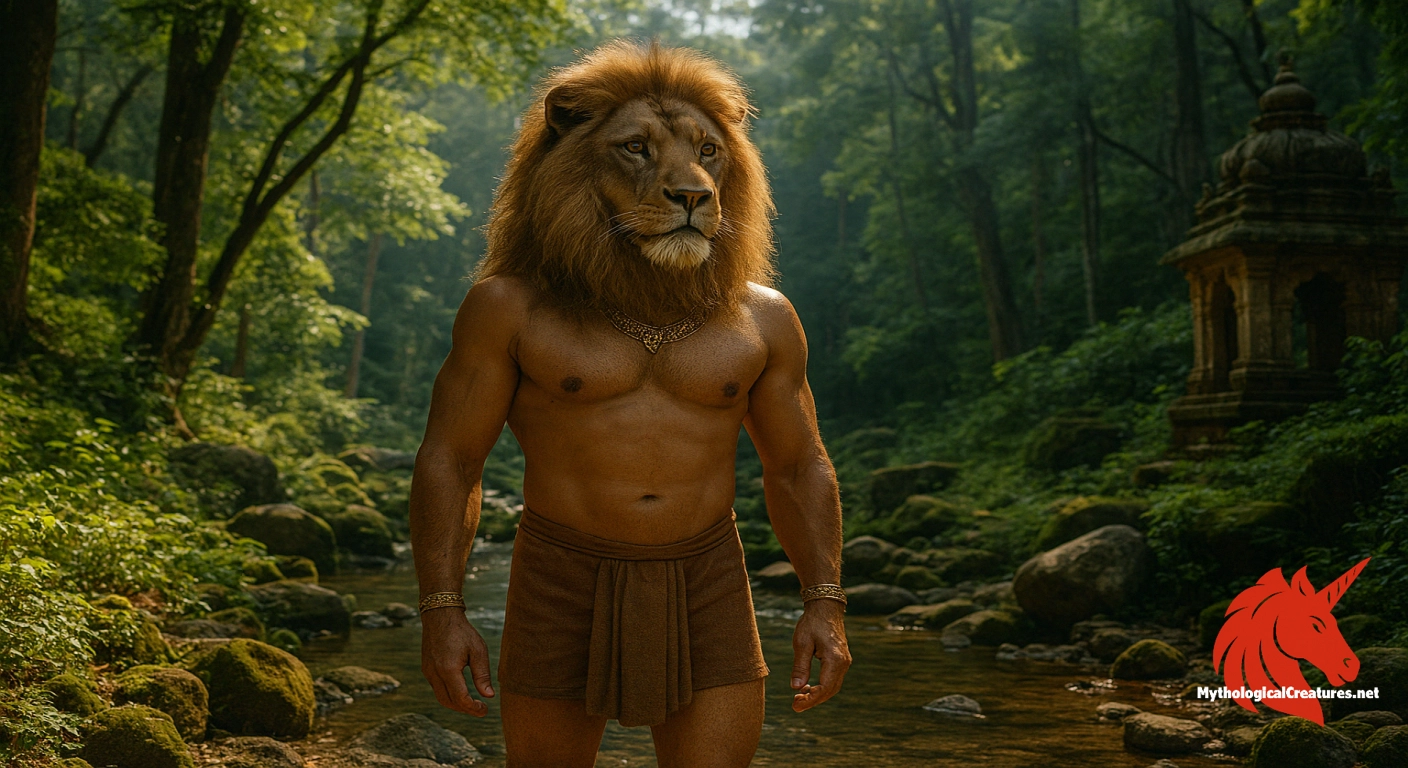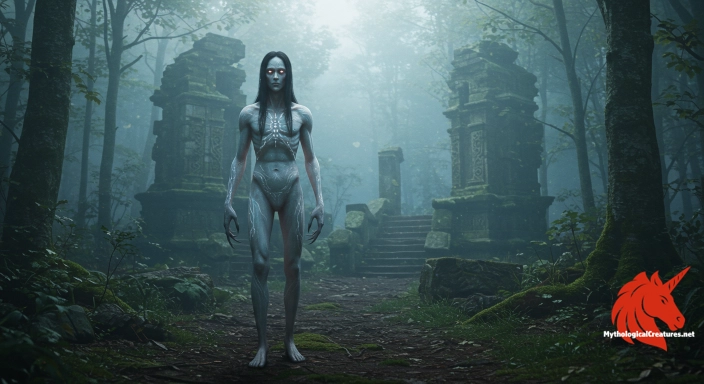Kimpurushas: The Kimpurushas are a race of lion-headed human beings from Hindu mythology.

Kimpurushas
Kimpurushas - The Kimpurushas embody the fusion of human wisdom and animalistic grandeur, serving as an integral part of Kubera's divine retinue and symbolising prosperity in Hindu cosmology.
Origins & First Encounters
The kimpurushas are a vibrant race of mythological beings that capture the imaginations of those who engage with ancient Hindu literature. Their unique form, merging the human body with the majestic head of a lion, has intrigued scholars and artists alike for centuries. Emerging from the mirage of early mythic traditions, they are believed to have played a role during the formative periods of cosmic order and divine hierarchy. Their distinct attributes are interwoven with the celestial narratives, particularly as they serve as attendants to Kubera, the deity of wealth and abundance. Intrinsic to their lore is a representation of both imperious strength and a transcendent wisdom that defies simple categorisation. Over numerous generations, artistic depictions and textual references have celebrated their ability to bridge the divide between the humanoid and the bestial. This duality has allowed them to occupy a unique space where earthly vigour meets divine inspiration in a seamless blend. Rich in cultural symbolism and historical resonance, the kimpurushas continue to exemplify the melding of human desire with the regal force of nature.
Source Texts & Tale Variants
Ancient literary traditions have chronicled the kimpurushas across a wealth of canonical texts, most notably within the Puranas where their mythic role is both celebrated and mystified. Early Sanskrit epics and subsequent commentaries mention them as part of the divine retinue, often aligning their presence with cosmic festivities and celestial order. In certain accounts, the kimpurushas are conflated with kinnaras, while in other narratives subtle distinctions are drawn that highlight their unique hybrid form. Various regional folklore traditions have also embraced these beings, enriching their narrative with local colour and imaginative reinterpretations. Some texts recount their origins during pivotal mythological events, such as the churning of the ocean, thereby linking them to the very fabric of cosmic creation. Additional layers of their mythos can be found in tantric and Buddhist literature where their characteristics merge with broader themes of transformation and enlightenment. Multiple story variants present them as both noble custodians and whimsical court jesters of the divine realm. This multiplicity of sources not only celebrates their enigmatic nature but also demonstrates the evolution of their myth across different eras and cultural milieus.
Form & Powers
The kimpurushas are traditionally depicted with a human form that exudes both poise and vitality, seamlessly joined with the commanding head of a lion. Their anatomical features blend the elegance of human structure with the formidable aspects of a lion’s visage, complete with a mane that symbolises both regality and raw power. Often, the eyes of these creatures are portrayed as deep and expressive, suggesting layers of mystic insight and an inner fire that mirrors their dual nature. The facial contours of the lion head are carved with precision, showcasing features that range from fierce determination to a dignified calm. In artistic renditions, their upper bodies are adorned with delicate ornamentation, reinforcing their elevated status as attendants of the divine. Variations in size and form can be observed across differing regional artworks, with some emphasising robust strength while others highlight a more statuesque grace. The melding of human and animal characteristics in their design serves as a visual metaphor for the interplay between intellect and instinct. This rich iconography, celebrated in sculptures, paintings, and temple engravings, continues to inspire a sense of awe and wonder with its harmonious blend of beauty and ferocity.
Regional Faces
The portrayal of the kimpurushas varies considerably across the diverse cultural landscapes of India and its neighbouring regions. In North India, for instance, temple carvings and classical paintings often depict these beings with a stern, almost monumental grace that underscores their strength and connection to divine wealth. In contrast, South Indian traditions sometimes soften their features, presenting them as jovial and approachable figures in local folklore. In Nepalese and Tibetan narratives, regional adaptations have merged their imagery with indigenous deities, resulting in iconographies that are both colourful and rich in symbolic detail. Local traditions sometimes cast the kimpurushas in roles that emphasise community beneficence and cosmic balance, reflecting the local ethos. Their presence in festive rituals and village legends underscores a multifaceted identity that adapts to the cultural expectations of each locale. Despite these variations, the core duality of a human body paired with a lion’s head remains a unifying constant that signifies both earthly resilience and divine oversight. These regional adaptations enrich their myth, making the kimpurushas a truly pan-Indian symbol whose essence transcends singular cultural constraints.
Cultural Parallels
In the wider compendium of world mythology, the kimpurushas stand beside other hybrid beings as captivating emblems of nature’s duality. Unlike the classical Egyptian or Greek sphinx, which traditionally feature a human head atop a lion’s body, the kimpurushas invert this iconic formation by donning a lion’s head with a human form, thereby offering a distinct narrative approach. Their portrayal is reminiscent of other mythic hybrids that attempt to reconcile the contradictory aspects of human rationality and animal instinct. Similar to the griffins of European legend, they also function as protectors and gatekeepers in their respective mythologies. Fascinating parallels can be drawn with the kinnaras, with whom they share both overlapping traits and contrasting roles, highlighting the diversity of interpretation within the same cultural sphere. These cross-cultural connections illuminate a universal curiosity, where diverse societies seek to explore the boundaries between the terrestrial and the transcendent. By comparing these mythic figures, one can understand how different cultures articulate concepts of power, wisdom, and the inherent mysteries of existence. Ultimately, the kimpurushas contribute to a global narrative in which the fusion of human and animal forms symbolises the timeless exploration of what lies beyond the ordinary.
Legacy & Modern Evolution
Over the centuries, the image of the kimpurushas has undergone an intriguing evolution, reflecting the shifts in philosophical and aesthetic paradigms. Early depictions in classical literature and temple art established them as potent symbols of divine wealth and cosmic order, a legacy that has been continuously reinterpreted over time. In modern artistic circles, they have been resurrected as icons of hybridity, merging ancient symbolism with contemporary artistic expression in both literature and visual media. Recent portrayals in fantasy films, graphic novels, and digital illustrations often present them as guardians of both the natural and supernatural realms, bridging antiquity with modern storytelling. The kimpurushas now frequently appear in academic discussions and cultural exhibitions, where they serve as a testament to the enduring nature of myth. Modern interpretations often emphasise their role in symbolising the unity of the animalistic and the intellectual, thereby providing a rich metaphor for contemporary dialogues on identity and wisdom. Their depiction has come to represent a broader cultural synthesis, inviting new generations to rediscover ancient lore through the lens of modern creativity. This evolving legacy not only invigorates the myth but also ensures that the kimpurushas remain relevant in an ever-changing cultural landscape.
Interesting Fact
An interesting aspect of the Kimpurushas is that they are sometimes considered equivalent to the kinnaras, revealing the fluid and evolving nature of mythological classifications in ancient texts.
Quick Creature Info
Our Mythic Legendary Rating:

Also Sometimes Known As:
Habitat:
Supernatural Powers:
Physical Attributes:
Abilities:
Behavior:
Lore:
Related Creatures, Tales or Lore
- KKinnaras
- NNarasimha
- VVyala
References
Discover Another Mythical Legend You May Not Have Heard Of?
Uncover the mysteries of ancient folklore and expand your knowledge of legendary beings from cultures around the world.
Dare to Meet the Blud....
Mythical Disclaimer: The images and data on this site are derived from various historical and literary sources, but we have found that many myths often have multiple versions and interpretations across references, sometimes contradictory. As a result, these creature depictions are artistic interpretations—imaginative blends of folklore, legend, and a dash of AI guesswork. Because creature descriptions vary widely, our illustrations and accompanying information represent our best effort to honor mythology while bridging creative gaps. Enjoy these interpretations—just remember, we've done our best to respect the stories and validate available data, but in the realm of mythology, details often shift, imagination leads the way, and nothing is ever set in stone!
Curated by the Mythological Creatures Team (rev. May 2025)
